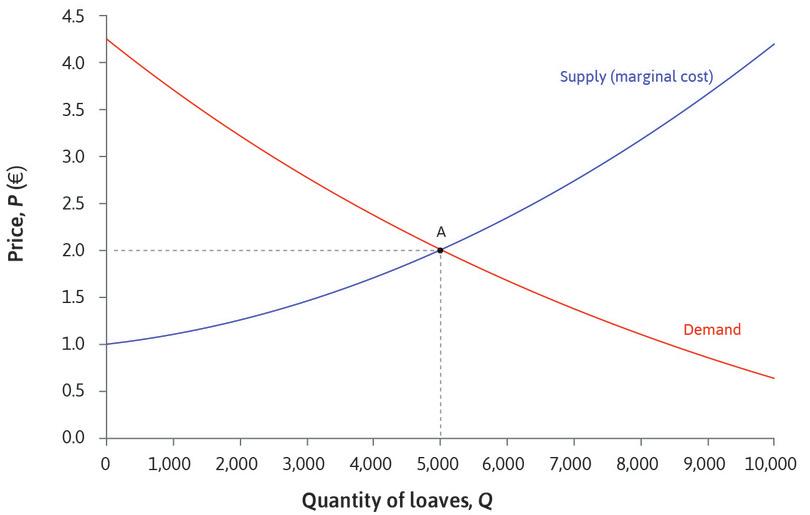Leibniz
8.4.2 Market equilibrium
A market is in competitive equilibrium if all buyers and sellers are price-takers, and at the prevailing market price, the quantity supplied is equal to the quantity demanded. In this Leibniz, we see how to find the equilibrium price and quantity mathematically, from the market supply and demand curves.
Consider a market, like the market for bread described in Unit 8, in which all buyers and sellers are price-takers. Suppose that the market demand function is , and the market supply function is , derived as in Leibniz 8.4.1. The demand curve gives the total amount of a good demanded at each price by the buyers in the market, and the supply curve tell us the total amount sellers are willing to supply at each price. The supply and demand for bread is shown in Figure 8.8 of the text, reproduced below as Figure 1 (remember that we typically draw both with on the vertical axis and on the horizontal—so the graph actually shows the inverse demand and supply functions).
To find the equilibrium price and quantity, we need to solve a pair of simultaneous equations—the demand curve and the supply curve—for and .
When the demand and supply curves are expressed in terms of the direct demand and supply functions and , we can start by looking for an equilibrium price—that is, a price that clears the market, equalizing the quantities demanded and supplied. An equilibrium price is a solution of the equation:
In standard cases like the one shown in Figure 1, where is an increasing function and a decreasing one, there is at most one equilibrium price. Having found the equilibrium price by solving this equation, the equilibrium quantity may be found by substituting the equilibrium price back into the supply or demand equation. In Figure 1 the equilibrium price is €2, and the corresponding quantity is 5,000 loaves.
Example
Let us suppose that the market demand and supply functions are both linear:
where are constants. We assume that and , so this is an example of the standard case in which demand slopes downward, and supply slopes upward. We need to ensure that there is some demand for the good if the price is low enough. We also assume that . (If , supply exceeds demand at all positive prices. When we stated above that there is ‘at most one’ equilibrium price, we were allowing for cases like this in which no equilibrium price exists.)
The equilibrium price is the solution of the equation:
Solving this equation gives us
and the quantity demanded and supplied in equilibrium is given by:
is positive if and only if . If this condition does not hold, then there is no market equilibrium in which a positive quantity of the good is traded.
Read more: Section 1.2 of Malcolm Pemberton and Nicholas Rau. 2015. Mathematics for economists: An introductory textbook, 4th ed. Manchester: Manchester University Press.

